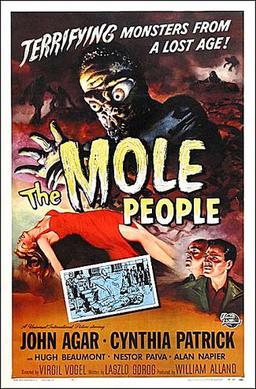27 October 2010
Geological Frightfest: The Mole People
Posted by Jessica Ball
I thought I’d go with a classic film for today’s edition of Geological Frightfest, because the premise of The Mole People is just so interesting. It’s not actually one I’ve seen, and I know a lot of younger readers probably won’t have ventured into the realm of 1950s horror, so here’s a bit of summary from Wikipedia:
“The film begins with a narration by Dr. Frank Baxter, an English professor at the University of Southern California, explaining the premise of the movie and its basis in reality. He briefly discusses the hollow earth theories of John Symmes and Cyrus Teed among others, and says that the movie is a fictionalized representation of this unorthodox point-of-view.
 “In this movie, archaeologists Dr. Roger Bentley and Dr. Jud Bellamin stumble upon a race of Sumerian albinos living deep under the Earth. They keep mutant humanoid mole men as their slaves to harvest mushrooms, their primary food source, since they can grow without sunlight. The Sumerian albinos’ ancestors moved into the subterranean after the cataclysmic floods in ancient Mesopotamia.”
“In this movie, archaeologists Dr. Roger Bentley and Dr. Jud Bellamin stumble upon a race of Sumerian albinos living deep under the Earth. They keep mutant humanoid mole men as their slaves to harvest mushrooms, their primary food source, since they can grow without sunlight. The Sumerian albinos’ ancestors moved into the subterranean after the cataclysmic floods in ancient Mesopotamia.”
The mention of the “Hollow Earth” idea was what caught my eye. In college, I took a freshman seminar called “Applied Pseudoscience”, where we discussed logical fallacies and pseudoscience topics like this theory; our textbook was the venerable Fads and Fallacies in the Name of Science by Martin Gardner (1952), and that’s where I turn whenever hollow Earth ideas get mentioned. Captain John Cleves Symmes first came up with the idea of a hollow Earth in 1818, when he suggested that the Earth was made up of five concentric spheres, both sides of which sustained plant and animal life, with huge openings at the poles. (He campaigned for years trying to get the U.S. Congress to fund an expedition to the North Pole, without success, and died in 1829 from the strain of constant campaigning.) Cyrus Reed Teed, another 19th century American, tried to advance an even more bizarre idea – that we were living on the inside of a hollow sphere, with the sun, moon, planets and stars inside the hollow and nothingness outside. (According to this idea, the internal sun is half light and half dark and rotates, thus producing day and night. If you think the sun is a light bulb, that sort of makes sense; it’s when he starts talking about planets as “spheres of substance aggregated through the impact of afferent and efferent fluxions of essence” that I get lost.)
The idea had been mentioned even earlier than the 19th century, however. Edmund Halley published an essay in 1692 describing an Earth with a shell 500 miles thick, two inner shells the size of Mars and Venus, and a solid inner sphere the size of Mercury (all of which should be capable of bearing life). A particularly brilliant display of the aurora in 1716 prompted him to suggest that the lights were caused by glowing gas escaping from thin spots in the outer sphere at the poles. Doubtless there were many people before Halley who came up with similar ideas, perhaps related to the idea of an underworld – although they probably never came up with something as odd as mushroom-harvesting mutant mole men!
PS – It looks like you can read a pretty good chunk of Fads and Fallacies via Google Books, and I highly recommend it; it’s a pretty funny book and covers a lot of pseudoscientific topics, although it can get a bit dense in parts.


 Jessica Ball is a volcanologist at the U.S. Geological Survey, researching volcanic hydrothermal systems and stability, and doing science communication for the California Volcano Observatory. She previously worked at the Geological Society of America's Washington DC Policy Office, learning about the intersection of Earth science and legislative affairs. Her Mendenhall postdoc and PhD focused on how water affects the stability of volcanoes, and involved both field investigations and numerical modeling applications. Her blogging covers a range of topics, from her experiences in academic geosciences to science outreach and communication to her field and lab work in volcanology.
Jessica Ball is a volcanologist at the U.S. Geological Survey, researching volcanic hydrothermal systems and stability, and doing science communication for the California Volcano Observatory. She previously worked at the Geological Society of America's Washington DC Policy Office, learning about the intersection of Earth science and legislative affairs. Her Mendenhall postdoc and PhD focused on how water affects the stability of volcanoes, and involved both field investigations and numerical modeling applications. Her blogging covers a range of topics, from her experiences in academic geosciences to science outreach and communication to her field and lab work in volcanology.